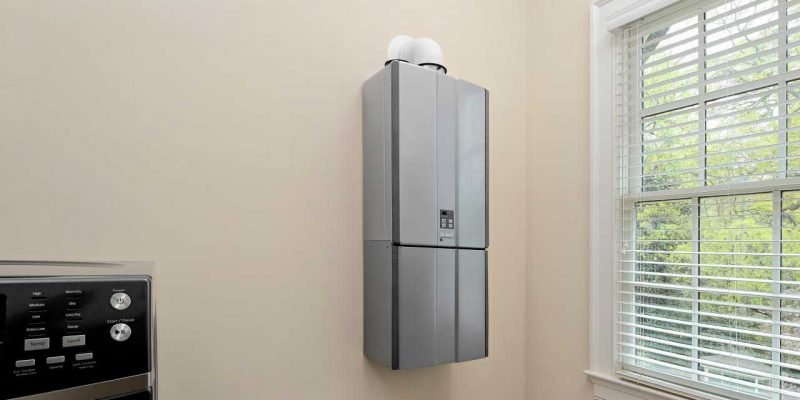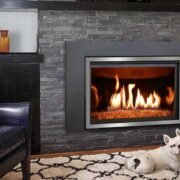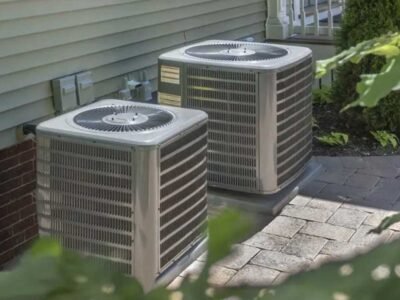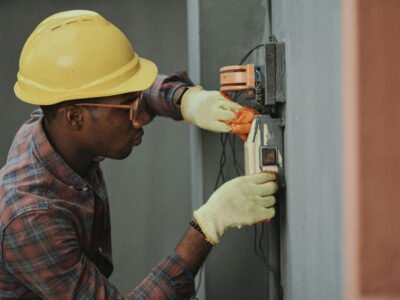It is important to know that interior and exterior models are available when buying tankless water heaters. It is mostly the venting that makes the difference between the models. A common question among buyers relates to venting of gas tankless water heaters.
Typically, exterior gas units feature a front vent that is not suitable for interior use. When buying a tankless water heater, it’s important to consider your family’s needs, otherwise you may select the wrong one. Are tankless water heaters required to be vented if they are installed inside?
Ventilation is required for indoor tankless water heaters. The exhaust vents on indoor models are all adjustable. Additionally, indoor models need either a direct vent or a power vent to make fresh air flow. Models with direct vents provide fresh air from outside and are easy to install at small spaces. Powered vent heaters pull fresh air from surrounding interior spaces and require that a large amount of air is available for combustion.

For gas tankless water heaters built outside, vents are built into the unit’s front, which means no additional vent piping is necessary. There is no need for venting with electric tankless water heaters, regardless of their location.
Proper ventilation is vital to install tankless water heaters safely and functionality. If you lack it, you may suffer from carbon monoxide poisoning, which can be extremely harmful and even fatal.
In addition to the most important factors, we’ve gathered the guidelines, which should be used in conjunction with the manufacturers’ instructions. Keep reading to learn how to set up a tankless water heater in a safe and efficient manner.
Tankless Gas Water Heaters that Need to be Vented
It is absolutely amazing how a tankless propane or natural gas water heater can reduce energy consumption by up to 50%, along with reducing greenhouse gas emissions by 61%. The venting must be done properly, however, to ensure efficiency and functionality as well as safety requirements. Where tankless water heaters are installed depends on the venting type; either direct vent or power vent.
Whether fueled by propane or natural gas, tankless water heaters must be vented effectively. A sidewall or roof can be used to vent them; however, you should always choose the shortest path possible. Due to the combustion fan exhausting horizontally, tankless water heaters can terminate on a sidewall.
PVC or Stainless steel vent pipes are used to vent corrosive gas from tankless water heaters so that they are not damaged. A galvanized vent from a tank water heater or furnace will rust soon when connected to a tankless heater.
Tankless Water Heater Vent Types
Tankless water heaters have a variety of vents, each with a different function, price range, spatial needs, and benefits. Tankless water heaters must be positioned correctly. Their size and placement, the need for air intake, as well as the requirements for space will greatly impact the vent selection.
Power Vent
For combustion, power vent systems use indoor air from the home, which is exhausted outside for regulation. Since power vent units have this functionality, they only require one exhaust vent. In an area with spatial constraints, these units require more space and make use of sufficient air.
Direct Vent
Units that use direct vents have two vents, one of which serves as an intake component, bringing outside air into the building and one serving as an exhaust component.
During the installation process, direct vent units can be installed in smaller areas, such as closets, resulting in less excess air in the immediate environment. Approximately 16 square feet of space can be saved, thus making them an excellent choice if space is an issue.
Concentric Vent
Concentric vents are two separate vents in one; one that acts as both an intake and exhaust vent.
In most cases, manufacturers offer concentric vents to get the best characteristics of both direct vent and power vent units.
In a concentric vent pipe there is a direct intake pipe and an exhaust pipe. Basically, this means that the heat is regulated by one vent or hole in the sidewall or ceiling. Also, as the air is warm and remains inside, the temperatures remain cool to the touch.
Consequently, tankless water heaters require less space for installation. A concentrated vent is not as hot as a direct vent.
Concentric vents offer these benefits, along with the distinction that exhaust air is contained, which means that harmful gases are prevented from being emitted into the home.
Despite their safety and convenience advantages, concentric vents are generally larger, vent pipe sizing is important to know. The pipes are approximately 5 inches in diameter rather than the typical 3 inches.
It’s not only quite possible but also quite easy to ensure that your tankless water heater will be properly vented. Available solutions award different benefits and are suitable for a wide range of budgets and scenarios.
In order to ensure safety, functionality, and comfort, an efficient venting system is essential.
Do Electric Tankless Water Heaters Need to be Vented?
An electric tankless water heater is not affected by venting like a gas or propane tankless water heater. Tankless electric water heaters heat water quickly via electric burners. As neither natural gas nor propane is used, no venting is required. These factors were some of the most influential factors in the popularity of electric tankless water heaters.
The absence of venting means an electric tankless water heater doesn’t lose as much heat as its gas equivalent. Electric tankless water heaters have a far higher efficiency and cost-effectiveness than gas tankless water heaters, with an average of about 99% efficiency compared with an average of about 80% – 85% for gas tankless water heaters.
On the whole, tankless water heaters can operate efficiently and last longer if the venting is done properly.
For the tankless water heater to function effectively and safely, as well as to reduce or eliminate any possibility of danger, following the manufacturer’s instructions is essential to the installation process.

















Comments